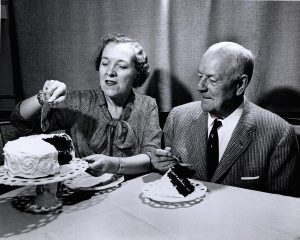This is an outstanding story by Nicole Jankowski, a freelance food, history and culture writer based in Detroit, who writes Duncan Hines, traveling salesman and future purveyor of boxed cake mix, considered himself an authority on a great many things: hot coffee, Kentucky country-cured ham and how to locate a tasty restaurant meal, in 1935, for under a dollar and a quarter.

In 1957, Duncan Hines and his wife, Clara, cut a cake at the Duncan Hines test kitchen in Ithaca, N.Y.
By the 1950s, Hines’ name would be plastered on boxes of cake mix; housewives would turn to his products for consistent quality and superior taste. Newspaper photographs featured Hines clad in a white chef’s apron, hoisting a neatly frosted cake or thoughtfully dipping a spoon into a mixing bowl.
But Duncan Hines wasn’t a chef — in truth, he could barely cook. For most of his career, he had just been a businessman, desperate for a decent meal on the road. Through his search for the best restaurants across America, he became an accidental gourmand, an unlikely author and homegrown connoisseur.
Although boxed cake mix is the legacy that most people now associate with Duncan Hines (only after asking, “Was he actually a real person?”) the supermarket foods that bear his name are only an epilogue to a storied life traveling America’s back roads.
It was really his book, Adventures in Good Eating, that first put Duncan Hines on the map. And it was his tireless pursuit of good food that inspired his book.
Hines’ appreciation for a good meal arose out of mere necessity. From the 1920s through the ’40s, he motored across the country hawking letter openers and paperclips and subsisting on unreliable road food. It was an era long before any formal restaurant rating system existed in the U.S. The names and locations of good restaurants were conveyed by word of mouth; for an out-of-town traveler, locating a decent supper was often a daunting and discouraging mission. And although Europe had relied on The Michelin Guide since 1900, middle America in the 1920s and ’30s was still a land of culinary mystery and inconsistency.
Desperate for a clean place to dine, Hines became an investigative epicurean and self-made restaurant critic. He carried a tiny journal in his coat pocket, jotting down the precise locations of his favorite places. No restaurant was off limits for the inquisitive Hines. “The kitchen is the first spot I inspect in an eating place,” he wrote. “More people will die from hit or miss eating than from hit and run driving,” he joked — though Hines clearly thought food safety was no laughing matter.
He frequently popped into the kitchen to scrutinize how staff handled food and then swung around back to investigate the restaurant’s garbage pile. He meticulously recorded the names of the most pristine diners, the inns with the tastiest prime roast beef, and where to find the stickiest honey buns. He appreciated regional cuisine, quickly discovering in which part of the country to brake for broiled lobster tail (New England) and where to stop for fried chicken (Kentucky).
Hines noted whether a restaurant had air conditioning, its hours of operation and its prices for breakfast, lunch and dinner. “His restaurant notes were extraordinarily accurate,” says Louis Hatchett, author of the book, Duncan Hines: How a Traveling Salesman Became the Most Trusted Name in Food. “As word spread among his family and friends, people were begging him to share the list he had created. There was nothing out there like it,” he says. “In 1935, sick of being pestered, he finally sent out a little blue pamphlet in his Christmas cards, containing a list of 167 restaurants across 33 states that he could safely recommend.”
Soon, Hines was receiving postcards from from salesmen, newlyweds and other travelers all over America seeking his recommendations for good, clean restaurants.
In 1936, at 55, Hines self-published his first edition of Adventures in Good Eatingand sold them for $1 each. It contained the names and locations of 475 restaurants from coast to coast that had Hines’ rigorous seal of approval. “The books were sold through word of mouth, but they quickly sold out. The following year he raised the guide’s price to $1.50 — and that’s where the price would stay for the next 25 years,” explains Hatchett.
“Recommended by Duncan Hines” became the gold standard in dining by the 1950s.
Two years before his death in March of 1959, the entire franchise was sold to Procter & Gamble.
Hines often said, “Nearly everyone wants at least one outstanding meal a day.” This seems as true now as it did a half-century ago. But long before Yelp or TripAdvisor offered restaurant reviews with the click of a button, Hines was doing it his own way, by traveling the highway with his pencil and notebook, changing the way America ate on the open road — one adventure at a time.

 The FDA advised consumers not to bake with or eat any recalled cake mix. If already purchased, consumers should throw it away or return to the place of purchase for a refund.
The FDA advised consumers not to bake with or eat any recalled cake mix. If already purchased, consumers should throw it away or return to the place of purchase for a refund.


